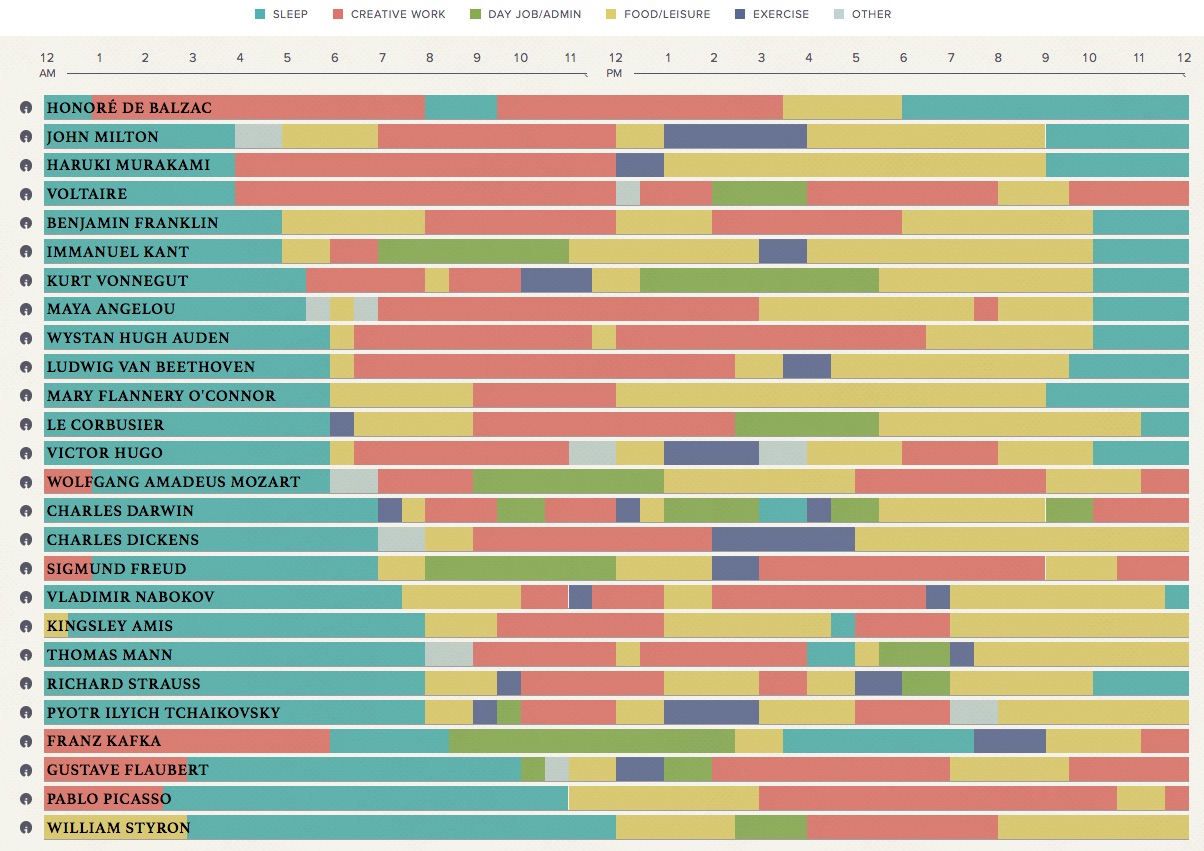Due: 10/2
Objectives:
- Introduction to data visualization, which we'll be doing a lot more with during the latter half of the semester.
- Experience gathering data, making decisions about what counts or doesn't, considering the difficulties in that process. Later in the semester, you'll be working with data sets that are given, so I want you to have a sense of some of the ways in which data can be messy.
When Mason Currey wanted to understand how he could manage to produce more creative work despite the challenges of everyday life, he set about studying how a bunch of other famous creative people organized their daily lives and what routines they established for their own creative work with the assumption that there were valuable lessons there. Daily Rituals was the result of that research — and then a number of different people and organizations have set out to visualize the insights of that book so that we can see larger patterns in the midst of all this biographical information. Podio’s graphic, which is the feature image on this post, is one of those (check out their site for the interactive version)
For this sketch assignment, you will choose one concept in your life that you want to analyze, something that is not already easily and obviously measured, or doesn’t vary within the span of a day or a week (good categories: awesomeness, mindfulness, healthiness, creativity, productivity, and similar … bad categories: number of steps, hours of sleep, caloric intake, how good is my eyesight?). Decide on a set of about 5 categories that you can use to measure that concept in your life and track those categories for a week or more, then you will produce a visualization of the data that you have gathered and use that visualization to help you understand something about your own life that might not be obvious from your own day to day activities.
Tracking Data
If you’re looking for suggestions about what to track, browsing the “quantified self” tag at Lifehacker might be worthwhile.
Once you’ve got categories, create a spreadsheet where you can track those categories throughout the day. Either take notes in a journal or on your phone and enter the results into your spreadsheet at set intervals, or make the spreadsheet in Google Drive and access it from your phone, or use the site Trackthisforme, or install a tracker app on your mobile device (I found some by searching for “quantified self” apps).
In “How to Track Everything in Your Life Without Going Crazy” and “Fill Out This One-Minute Form Every Day and Find Out Why Your Life Sucks (or Doesn’t)” Adam Dachiss has some useful suggestions for measuring stuff in your life. “Why You Should be Tracking Your Habits and How to Do It” by Belle Beth Cooper is also useful. However, all three of those articles are a few years old now and might not be perfectly applicable.
Whatever method you use, the key activity is to decide what you are going to pay attention to and then to create a system that is manageable for your life for the span of a week wherein you will quantify information about your self or your behavior.
For example, one step of this process might be to decide to measure how happy you are and to create a spreadsheet with a column for “Happy.” Then when you wake up in the morning, while you’re waiting for the coffee to brew, you’ll pull up the spreadsheet and enter a number between 1 and 10 indicating how happy you feel. You will continue adding rows at some set interval (every hour maybe). You will probably have some columns that are a little less subjective than “how happy do I feel right now?” (like “how many times did I talk in class today?” or “how much time did I spend studying?” “how many minutes have I spent looking at my phone in the last hour?”). You can decide how objective or subjective your categories are, but recognize that those decisions will impact the sorts of conclusions you draw from this process.
For now, you just need to decide what you will track and then to be as meticulous and careful as you can be about actually tracking this information either directly into a spreadsheet or in a format that can easily be transferred into a spreadsheet at the end of the week.
I will follow up with more information about visualizing that data once you’ve collected it, but don’t worry too much about that yet. Just collect data and pay attention to any patterns you notice while you do so.
Objectives for tracking data:
- Introduction to “distance reading” or “macroanalysis.” When you are going about your life, you notice certain kinds of things but when you find methods to step back and look for broader trends, you might notice other patterns.
- Later in the semester, we’ll be working with data sets that scholars have gathered, sorted, cleaned, and published. Gathering data from your own life will be an introduction to the sorts of messiness and difficult decisions that can go into such data gathering.
- Beginning to shift the narrative of this class from the personal to broader trends.

[…] you haven’t already started tracking data for the data visualization sketch assignment, start doing so as soon as possible. I want you to have at least one full week’s worth of […]
[…] this assignment, I decided to explore my mindfulness as I have noticed that I can be inattentive. In order to […]